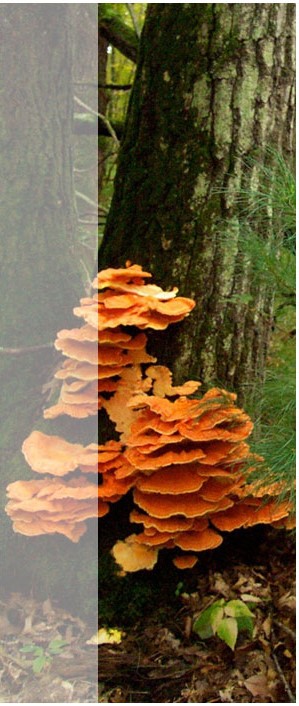Harvesting, Preserving, Preparing
Mushroom Etiquette – Harvesting
Never Forage Without a Guidebook
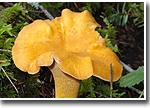 I carry Gary Lincoff’s National Audubon Society Field Guide to Mushrooms of North America. It is a compact size and packed full of information, not unlike the man himself. It is highly likely you will encounter something you are unfamiliar with. Do your identifying in the field to avoid carrying home a basketful of mushrooms that are of no use to you. (if you find yourself with a basket of mushrooms you cannot I.D., try making paper. Some can be used for dye).
I carry Gary Lincoff’s National Audubon Society Field Guide to Mushrooms of North America. It is a compact size and packed full of information, not unlike the man himself. It is highly likely you will encounter something you are unfamiliar with. Do your identifying in the field to avoid carrying home a basketful of mushrooms that are of no use to you. (if you find yourself with a basket of mushrooms you cannot I.D., try making paper. Some can be used for dye).
Respect Private Lands
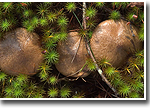 It is always important to follow signage and to respect private landowners rights to post their land. Do not trespass. Seek permission from the owner if they have a particularly enchanting area. It has been my experience that most landowners know only of morels so may be willing and even eager to let you forage for the many other edibles.
It is always important to follow signage and to respect private landowners rights to post their land. Do not trespass. Seek permission from the owner if they have a particularly enchanting area. It has been my experience that most landowners know only of morels so may be willing and even eager to let you forage for the many other edibles.
Plan Ahead
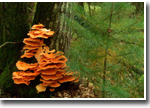 Be prepared for that amazing 30lb Sulphur Shelf or treasure trove of autumn fungi like Boletes and Scaber Stalks, Milkies and Sweet tooth. Bring several baskets so you can trade when one is full (paper grocery bags work in a pinch) A cooler is a good idea since sitting in a hot car would greatly hasten their deterioration…bring water and some nuts and fruit as a foray can last for hours so you will be grateful for snack. Be certain you do not leave garbage * Do not use tupperware or plastic containers or bags *
Be prepared for that amazing 30lb Sulphur Shelf or treasure trove of autumn fungi like Boletes and Scaber Stalks, Milkies and Sweet tooth. Bring several baskets so you can trade when one is full (paper grocery bags work in a pinch) A cooler is a good idea since sitting in a hot car would greatly hasten their deterioration…bring water and some nuts and fruit as a foray can last for hours so you will be grateful for snack. Be certain you do not leave garbage * Do not use tupperware or plastic containers or bags *
Use a Basket
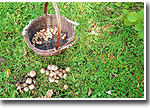 Plan ahead before you go out to for a foray.Mushrooms do not like plastic. It hastens their deterioration in the extreme. Ideally you would use a basket allowing airflow which is essential to keeping the mushrooms from degrading after harvest. It also allows for spore dispersal. If you find yourself without a basket a paper bag will work.
Plan ahead before you go out to for a foray.Mushrooms do not like plastic. It hastens their deterioration in the extreme. Ideally you would use a basket allowing airflow which is essential to keeping the mushrooms from degrading after harvest. It also allows for spore dispersal. If you find yourself without a basket a paper bag will work.
Carry a Pocket Lens
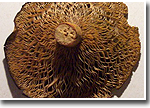 A magnifying glass will help you see the intricate details that will help you identify some fungi. The pores of Dryads Saddle or the vein-like pore structure of the Ash Tree Bolete are awesome with the naked eye but stunning with a hand lens. You can find small ones at antique stores for a reasonable sum.
A magnifying glass will help you see the intricate details that will help you identify some fungi. The pores of Dryads Saddle or the vein-like pore structure of the Ash Tree Bolete are awesome with the naked eye but stunning with a hand lens. You can find small ones at antique stores for a reasonable sum.
Dress Appropriately
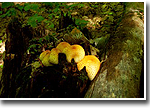 This especially goes for footwear. If you are hunting mushrooms in a swampy, boggy area of forest in Wisconsin, you’ll want Wellies, in the mountains of Colorado this would be inappropriate and hiking boots are more suited. In Wisconsin it is a good idea to wear long pants tucked in tall boots to avoid the tick that carries Lymes disease. When i harvest it is not unusual to encounter Prickly Ash, Raspberry brambles, thistles, burrs and a host of plant and insect combatants. Wear bug repellent if you will, I choose to cover up.
This especially goes for footwear. If you are hunting mushrooms in a swampy, boggy area of forest in Wisconsin, you’ll want Wellies, in the mountains of Colorado this would be inappropriate and hiking boots are more suited. In Wisconsin it is a good idea to wear long pants tucked in tall boots to avoid the tick that carries Lymes disease. When i harvest it is not unusual to encounter Prickly Ash, Raspberry brambles, thistles, burrs and a host of plant and insect combatants. Wear bug repellent if you will, I choose to cover up.
Use a Knife
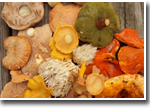 The tip is handy for removing debris or insects and by cutting the fungus you have a clean surface which makes it easier to check for worm holes and bug tunnels. Some people are “pullers”, I am a “cutter”. The part of the mushroom in the ground or attached to the tree is normally discarded. I believe when you pull the mushroom from the ground or tear it from the tree, you may be damaging minuscule communities and relationships that we do not understand. If we have indeed learned from our past endeavors, one of our lessons must be that there may be hidden consequences to our seemingly innocuous actions so I prefer to error on the side of caution.
The tip is handy for removing debris or insects and by cutting the fungus you have a clean surface which makes it easier to check for worm holes and bug tunnels. Some people are “pullers”, I am a “cutter”. The part of the mushroom in the ground or attached to the tree is normally discarded. I believe when you pull the mushroom from the ground or tear it from the tree, you may be damaging minuscule communities and relationships that we do not understand. If we have indeed learned from our past endeavors, one of our lessons must be that there may be hidden consequences to our seemingly innocuous actions so I prefer to error on the side of caution.
Identify and Clean Your Mushrooms in the Field
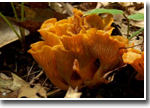 By doing this work in the field you avoid the inevitable deterioration that time and transport only facilitates. Making the identification in the field allows you to take notice of important characteristics concerning the surroundings at the present moment while assuring that you are collecting edibles. The cleaning process takes only a moment and if delayed can become much more tedious as the jostling around and being covered with other fungi lends itself to further pollution. Carry a long bristle brush like those suitable for stain. If you cannot clean the mushroom with the pointed tip of your knife or a brush best to leave it. Sand and dirt in a meal with wild mushrooms is ruinous.
By doing this work in the field you avoid the inevitable deterioration that time and transport only facilitates. Making the identification in the field allows you to take notice of important characteristics concerning the surroundings at the present moment while assuring that you are collecting edibles. The cleaning process takes only a moment and if delayed can become much more tedious as the jostling around and being covered with other fungi lends itself to further pollution. Carry a long bristle brush like those suitable for stain. If you cannot clean the mushroom with the pointed tip of your knife or a brush best to leave it. Sand and dirt in a meal with wild mushrooms is ruinous.
Tread Lightly
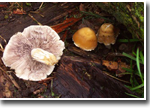 When we forage for wild mushrooms we are entering a community. If you can not stick to a trail, step carefully as there are countless beings beneath your feet. If you bring snacks and beverages make sure the wrappers and containers are safely stowed when empty so you do not leave garbage behind.
When we forage for wild mushrooms we are entering a community. If you can not stick to a trail, step carefully as there are countless beings beneath your feet. If you bring snacks and beverages make sure the wrappers and containers are safely stowed when empty so you do not leave garbage behind.
Harvest Respectfully
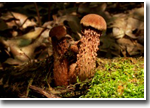 I was an herbalist before my study of mushrooms began and the “rule” was to harvest a third of what you find thus allowing for its use by other beings and the perpetuation of its kind. I follow the same rule for fungi. I also do not pick less than a quarter mile from blacktop which is also a “rule” when harvesting medicinal herbs.
I was an herbalist before my study of mushrooms began and the “rule” was to harvest a third of what you find thus allowing for its use by other beings and the perpetuation of its kind. I follow the same rule for fungi. I also do not pick less than a quarter mile from blacktop which is also a “rule” when harvesting medicinal herbs.
* LITTERING IS BAD KARMA *
Prepare and Preserve Your Harvest
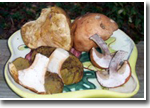 Although it can be quite an exhilarating experience to find that enormous mushroom patch, the task of processing all those treasures before they start to deteriorate can be daunting. The following are suggestions to ensure that you enjoy your bountiful harvest.
Although it can be quite an exhilarating experience to find that enormous mushroom patch, the task of processing all those treasures before they start to deteriorate can be daunting. The following are suggestions to ensure that you enjoy your bountiful harvest.
Use a Knife When Harvesting
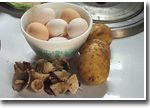 By using a knife you can eliminate much of the mess and tedium of the mushroom cleaning process. The stem of a terrestrial mushroom and the part attached to the tree are normally discarded. Many people remove the dirty parts with a knife before they add it to their basket. If you cut the mushroom immediately below the cap, you not only avoid disrupting whatever is clinging to the base, it also allows you to check for insects as they enter from the ground. The closer you are to the cap, the less likely you are to encounter the tunnels of hungry larvae. In the case of those growing on trees, the closer you are to the tree, the “woodier” the fungus will be and you are more likely to find larvae as they enter from the tree. In most cases, the most desirable part of a shelf fungus is the outer third and of the terrestrial mushroom is the cap. If you harvest in this manner, you will not pollute your basket with foreign matter that will only need to be removed later and you leave some behind to offer sustenance to another being and to perpetuate the species.
By using a knife you can eliminate much of the mess and tedium of the mushroom cleaning process. The stem of a terrestrial mushroom and the part attached to the tree are normally discarded. Many people remove the dirty parts with a knife before they add it to their basket. If you cut the mushroom immediately below the cap, you not only avoid disrupting whatever is clinging to the base, it also allows you to check for insects as they enter from the ground. The closer you are to the cap, the less likely you are to encounter the tunnels of hungry larvae. In the case of those growing on trees, the closer you are to the tree, the “woodier” the fungus will be and you are more likely to find larvae as they enter from the tree. In most cases, the most desirable part of a shelf fungus is the outer third and of the terrestrial mushroom is the cap. If you harvest in this manner, you will not pollute your basket with foreign matter that will only need to be removed later and you leave some behind to offer sustenance to another being and to perpetuate the species.
Process Your Harvest as Soon as Possible
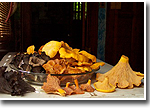 Not many things beat a meal of fresh wild mushrooms. Eating them sauteed on pasta or in scrambled eggs can be truly sublime. They are easy additions to soups, stews and chili. Fungi like Miatake make a great meat substitute and can be seasoned like taco meat for tacos and enchiladas. Many people hunt and there is nothing more suited to wild game than wild mushrooms in the stuffing or on the side. The possibilities are limitless.
Not many things beat a meal of fresh wild mushrooms. Eating them sauteed on pasta or in scrambled eggs can be truly sublime. They are easy additions to soups, stews and chili. Fungi like Miatake make a great meat substitute and can be seasoned like taco meat for tacos and enchiladas. Many people hunt and there is nothing more suited to wild game than wild mushrooms in the stuffing or on the side. The possibilities are limitless.
Make sure to use you harvest up within a few days at the most as refrigeration does not stop the deterioration process. If there are any larvae in the mushrooms you have collected, the refrigerator may slow them down but they will continue to devour your harvest and you may find quite a mess in the bowl where the mushrooms once were.
Preparation and Consumption
You can prepare fresh mushrooms in many ways for preservation, as well. Saute mushrooms in butter or oil and then freeze in containers for use in the off-season. Mushrooms preserve well this way. A home dehydrator works well on all but the small, delicate fungi. Small pieces will dry faster although sometimes you may want to preserve the entire cap. Dry Mushrooms will last indefinitely and look quite nice in glass jars.
Upon dehydration, mushrooms lose the “slimy” quality that many people find disagreeable. It also concentrates the flavor. I would not freeze mushrooms raw, as a rule, although Sulphur Shelf can stand it. Pickling is also an option I have tried. Some fungi work better than others. Choose firm mushrooms like Sulphur Shelf, Bolete bottoms or Blewits and avoid those with frilly gills. In my experience, the Sulphur Shelf kept its color and the mushroom blend looked appealing in jars and made lovely gifts.
* NAMASTE *
